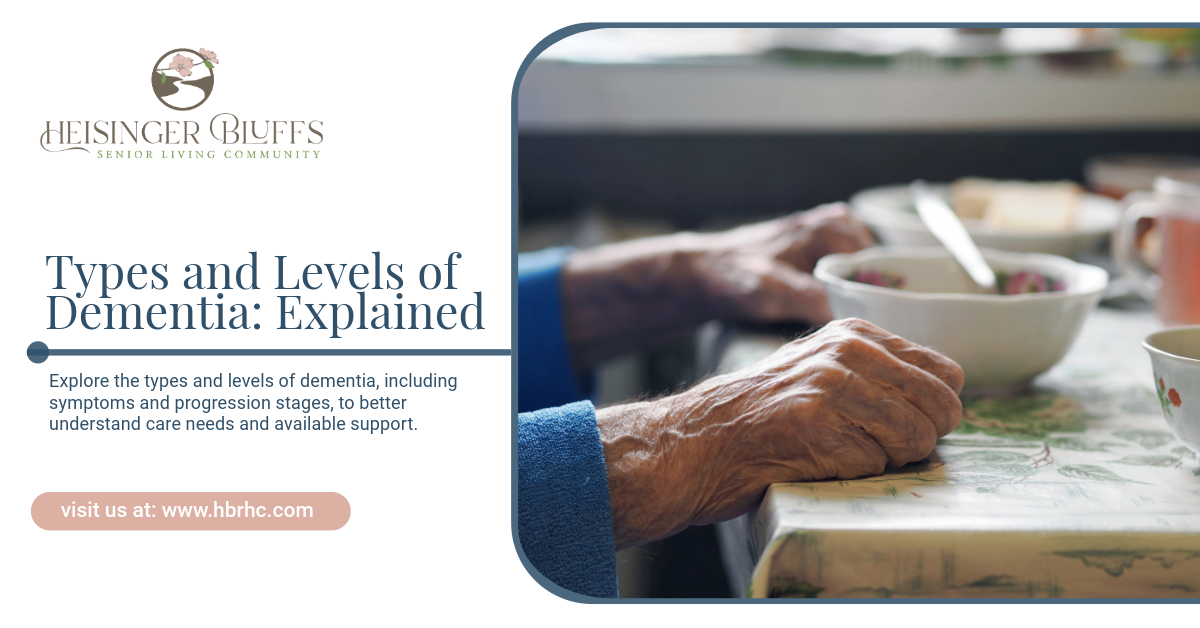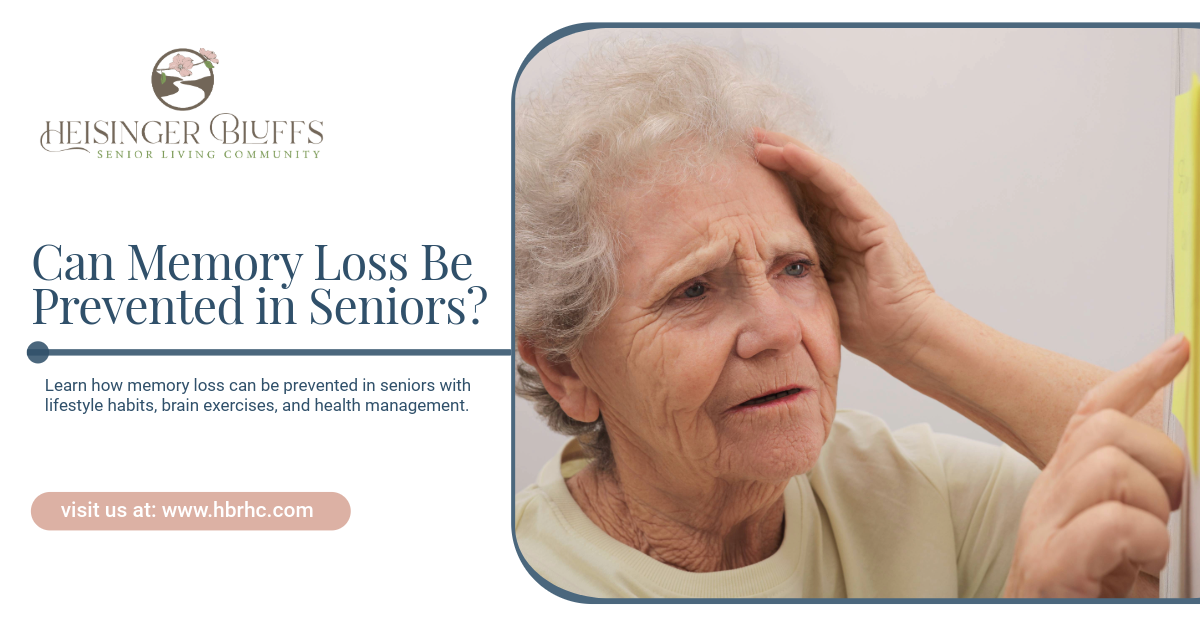Types and Levels of Dementia: Explained

Dementia is a general term used to describe a decline in cognitive function that interferes with daily life. While memory loss is a common symptom, dementia affects more than just memory—it can also impact language, judgment, problem-solving, and behavior. It's important to understand that dementia is not a single disease, but rather a syndrome caused by various conditions, each with unique symptoms and patterns of progression.
In this blog, we’ll explore the different types of dementia, the levels or stages commonly experienced, and what families can expect as the condition progresses. This knowledge can be invaluable when making decisions about memory care and long-term support.
What Is Dementia?
Dementia is caused by damage to brain cells, which interferes with their ability to communicate. This damage affects thinking, behavior, and emotions. While dementia is more common in older adults, it is not a normal part of aging.
Symptoms can vary greatly depending on the cause and which areas of the brain are affected. Most forms of dementia are progressive, meaning they worsen over time.
Common Types of Dementia
There are several types of dementia, each with its own set of symptoms and underlying causes. Understanding these types can help in planning appropriate care and treatment.
1. Alzheimer’s Disease
Overview: The most common form of dementia, Alzheimer’s disease accounts for 60–80% of all cases. It is characterized by the buildup of plaques and tangles in the brain that disrupt cell communication and lead to brain cell death.
Key Symptoms:
- Memory loss
- Confusion with time or place
- Difficulty with problem-solving or planning
- Withdrawal from social activities
- Mood and behavior changes
2. Vascular Dementia
Overview: Caused by reduced blood flow to the brain, often due to strokes or small vessel disease. It’s the second most common form of dementia.
Key Symptoms:
- Impaired judgment
- Trouble with focus and organization
- Slowed thinking
- Memory loss (less pronounced than Alzheimer’s)
- Sudden or step-wise progression after a stroke
3. Lewy Body Dementia
Overview: Associated with abnormal protein deposits (Lewy bodies) in the brain. It often overlaps with symptoms of Parkinson’s disease.
Key Symptoms:
- Visual hallucinations
- Sleep disturbances
- Muscle rigidity and tremors
- Attention fluctuations
- Memory issues
4. Frontotemporal Dementia (FTD)
Overview: A group of disorders caused by nerve cell loss in the brain’s frontal and temporal lobes.
Key Symptoms:
- Personality and behavior changes
- Lack of empathy or inhibition
- Language difficulties
- Compulsive or inappropriate behaviors
5. Mixed Dementia
Overview: A combination of two or more types of dementia, typically Alzheimer’s and vascular dementia.
Key Symptoms:
- Vary based on which types are present
- May include memory loss, mood changes, and impaired judgment
6. Parkinson’s Disease Dementia
Overview: Occurs in some individuals with Parkinson’s disease, usually in the later stages.
Key Symptoms:
- Movement issues
- Memory loss
- Depression and anxiety
- Difficulty concentrating
7. Other Rare Types of Dementia
- Creutzfeldt-Jakob Disease: Rapid progression and motor impairment
- Huntington’s Disease: Genetic disorder causing cognitive and motor decline
- Normal Pressure Hydrocephalus (NPH): Caused by fluid buildup in the brain; sometimes reversible
A Comparison: Common Types of Dementia
| Type of Dementia | Key Symptoms | Progression Speed | Unique Characteristics |
|---|---|---|---|
| Alzheimer’s | Memory loss, confusion, personality changes | Slow and gradual | Most common form |
| Vascular | Impaired judgment, step-wise decline | May be sudden | Often stroke-related |
| Lewy Body | Hallucinations, movement issues | Fluctuating | Linked to Parkinson’s |
| Frontotemporal | Behavior and language changes | Faster than Alzheimer’s | Earlier onset (50s–60s) |
| Mixed | Combination of symptoms | Variable | Often underdiagnosed |
The Levels or Stages of Dementia
Dementia is typically divided into stages to describe the progression of symptoms and care needs. While the exact breakdown can vary, most medical professionals recognize three main levels: early, middle, and late stage.
1. Early Stage (Mild Dementia)
At this stage, individuals may function relatively independently but begin to experience noticeable changes.
Symptoms:
- Short-term memory loss
- Trouble managing finances or planning
- Difficulty finding the right words
- Mild disorientation
- Mood changes or anxiety
Care Needs:
- Occasional supervision
- Help with complex tasks like medication management or transportation
2. Middle Stage (Moderate Dementia)
This stage often lasts the longest and includes more pronounced cognitive and behavioral symptoms.
Symptoms:
- Increased memory loss and confusion
- Difficulty recognizing loved ones
- Repetitive speech or behaviors
- Wandering or getting lost
- Changes in sleep patterns
- Assistance needed for personal hygiene
Care Needs:
- Daily hands-on assistance
- Structured routines and environment
- Supervision for safety
3. Late Stage (Severe Dementia)
In the final stage, individuals lose the ability to communicate effectively and require full-time care.
Symptoms:
- Inability to speak clearly or respond to surroundings
- Loss of physical abilities (walking, swallowing)
- Significant personality changes
- Vulnerability to infections, especially pneumonia
Care Needs:
- 24/7 care and supervision
- Assistance with all activities of daily living (ADLs)
- Comfort care and palliative support
Recognizing When Help Is Needed
As dementia progresses, care needs grow. Families often begin by supporting a loved one at home but may later find that professional care becomes necessary. Warning signs that additional support may be needed include:
- Safety concerns (wandering, falls)
- Difficulty managing hygiene and medications
- Increased caregiver burnout
- Social withdrawal or behavioral changes
Early planning allows for smoother transitions and better quality of life.
How to Support a Loved One at Every Stage
Caring for someone with dementia requires flexibility, patience, and compassion. Here are some general tips by stage:
| Stage | Tips for Support |
|---|---|
| Early | Maintain routines, offer memory aids (notes, labels), stay socially active |
| Middle | Create a calm environment, limit choices, establish daily structure |
| Late | Focus on comfort, use non-verbal communication, provide sensory stimulation (music, touch) |
Final Thoughts
Dementia is a complex condition with many forms and stages. Understanding the types and levels of dementia can empower families to seek timely care, make informed decisions, and advocate for a loved one’s well-being. While each journey is unique, education and support make a significant difference.
Heisinger Bluffs offers specialized memory care services designed to meet individuals where they are—providing compassionate, expert care at every stage of dementia. Our approach focuses on dignity, engagement, and safety in a warm, community-centered environment. Contact us today!
Frequently Asked Questions
What is the most common type of dementia?
Alzheimer’s disease is the most common type, accounting for 60–80% of all dementia cases. It is a progressive condition that affects memory, behavior, and thinking.
Can someone have more than one type of dementia?
Yes. Mixed dementia is when two or more types occur simultaneously, such as Alzheimer’s and vascular dementia. This combination can complicate diagnosis and treatment.
Is dementia reversible?
Most types of dementia are not reversible, but some conditions that mimic dementia, such as medication side effects or vitamin deficiencies, can be treated. Early evaluation is important.
Sources:
- https://www.alz.org/alzheimers-dementia/what-is-dementia
- https://www.alzheimers.org.uk/about-dementia/types-dementia
- https://www.alz.org/alzheimers-dementia/what-is-alzheimers
- https://www.parkinson.org/understanding-parkinsons/10-early-signs
- https://www.nia.nih.gov/health/vascular-dementia/vascular-dementia-causes-symptoms-and-treatments
- https://www.ninds.nih.gov/health-information/disorders/creutzfeldt-jakob-disease











